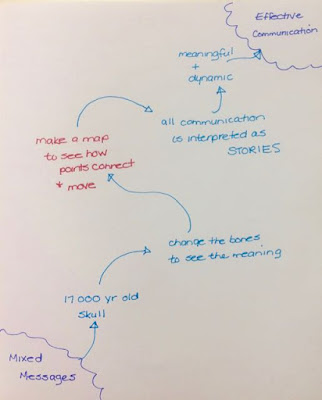Seeing to the bones of your message
I heard on the radio this morning that archeologists have discovered the skull of a 10 year old boy who died 17,000 years ago in Calabria, Italy. They are going to use the imprint his brain left on his skull to recreate the brain of the boy so that they can compare it to the brains of modern children. Learn more here.
There are always connections between the bones and the brain, between structure and meaning. Usually that connection is hidden by other stuff, the muscles and skin and decoration that make it hard to notice the frame underneath. By digging out the bones, you become aware of the meaning that sits behind your words and drives the effect they make.
Here are the bones of this post.
A skeleton like this gives you choices. The bottom left corner is for the current situation. The top right corner is for the change you want to make with your communication.
Now make a map (use arrows and place the points strategically) of the beginning and ending of your message and at least 3 main points that you will make in between. Look at the map of this post. Is it a post about finding meaning or a post about fighting miscommunications? Who is the main character and what does that character have to do to reach the top successfully?
Whether you think you are giving instructions or an explanation or a report, your listener or reader is likely to interpret your message as a narrative that unfolds through time. The bones show you that this blog post is a story about the way I connected a 17,000 year old skull to the need to find the story in your message so that your audience will be motivated to make change. In this case, I want you to follow me through seeing the bones, making connections and hearing the connections unfold as a story so that it motivates you to communicate more effectively.
This story has bones that says you have to unearth the story in your message if you want to be effective. If I moved the elements around, these same points might say that the best way to understand the meaning of a story is to reduce it to its bones. In that story, the main character would be someone who wants to interpret a message, not someone who wants to shape one.
But either story would have this at its heart: reducing your message to its bones won't strip away its dynamics and meaning. Instead, the bones will show you how to tighten connections so that your writing means and motivates.


Comments